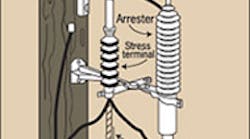A modern distribution system that feeds a facility having a significant environment of susceptible electronic equipment requires protection against lightning-induced overvoltages. And when an overhead power line — whether utility or end-user-owned — feeds that system, you need some sort of surge protection for the conductors on the riser pole that feed from the power line and connect into the service-entrance equipment. (See Sidebar, “Lightning and Underground Power and Signal Lines,”.)
Let's talk about some critical design and installation rules you should follow when designing and installing a pole-mounted overvoltage protection scheme.
Sizing surge arresters. Here are some important parameters you must consider when sizing lightning surge arresters.
Ratings. The basic impulse insulation level (BIL) of a power cable decreases as it ages, making it more susceptible to overvoltages. Therefore, it's important that you optimize any cable protection to avoid insulation breakdown and arcing, which can induce noise into an internal distribution system.
In doing so, it's critical that you do not determine the rating of the required protection simply by matching the arrester discharge rating with the cable BIL rating. You must also consider the phenomenon of voltage doubling, where a traveling overvoltage wave reaches a point of high resistance, such as at an open switch in a circuit, and reflects back with an amplitude almost double that at the point of reflection.
Protective margin (PM). This parameter is a measure of a surge arrester's ability to protect a piece of equipment or a system. The calculation involves the BIL withstand rating of the item to be protected and the arrester discharge level, which is usually listed in product literature and/or nameplates as “10kA IR discharge voltage of xxkV.”
Let's take a look at a sample PM calculation. Suppose you have power cables with 125kV BIL rating tapped from an overhead 24.9kV power line and feeding the primary of a padmount transformer. You want to know if a typical silicon-carbide (SiC) arrester mounted at the riser pole with a listed discharge level of 67kV is adequate.
At first glance, this arrester discharge level seems acceptable. But, if voltage doubling occurs within the cable, the surge voltage could rise to twice 67kV, or 134kV.
You can determine the PM by dividing the difference of the cable BIL rating minus twice the arrester discharge level and dividing the result by the cable's BIL. In other words, PM = (125kV - 134kV) ÷ 125kV = -9kV ÷ 125kV = -0.072. Rounding this value off, the PM is -7%. Because the PM is negative, you shouldn't use the SiC arrester because it cannot provide the required protection.
Some modern arresters, such as metal-oxide varistor (MOV) arresters, have lower and more consistent discharge protective levels than old-style SiC arresters. In fact, a typical MOV distribution arrester could have a 10kA IR discharge voltage of 59kV. So, if we double this rating, we get 118kV. Then, PM = (125kV - 118kV) ÷ 125kV = 7kV ÷ 125kV = 0.056 or approximately 6%.
Also, a typical MOV pole-mounted arrester, which is a higher-quality product, could have a 10kA IR discharge voltage of 52kV. Doubling this, we get 104kV. Then, PM = (125kV - 104kV) ÷ 125kV = 21kV ÷ 125kV = 0.168 or approximately 17%. These two types would provide adequate protection.
A note of caution here: The actual PM offered by an arrester will vary from the calculated PM value. This is because the surge protection industry calculates BIL margin percentages on the basis of the industry-standard 8×20-microsecond wave shape. (See March issue “Understanding Transients: A Primer” on page 38.) However, the actual wave shape of a lightning surge can be much faster than that of the 8×20-microsecond wave shape.
Surge arrester lead length. Lead length is a very important consideration in designing and/or installing the connections between pole-mounted surge arresters and medium-voltage (MV) cable terminators. PMs calculated from arrester catalog data don't include allowances for this variable.
Lead length is the combined length of the line lead and ground lead length in series with the arrester and in parallel with the device or cable being protected. For example, in Fig. 1 below, we see the arrester mounted near the MV cable stress termination, a line lead length of 12 inches, and a ground lead length also of 12 inches. So, the total arrester lead length is 24 inches.
The commonly accepted method of determining the effect of lead length on arrester operation is to use an inductance of 0.4 microHenries per foot of lead length and a lightning current rate-of-rise of 4000A per microsecond to determine L × di/dt voltage drop of the installation. Using this method, calculations show a 1.67kV addition to the discharge voltage of the arrester per foot of arrester lead length. This increase in discharge voltage actually reduces the extent of PM on the system.
In the installation shown in Fig. 1, the effective 10kV IR discharge voltage rating of the riser-pole arrester is increased from 52kV to 55.2kV as a result of the addition of 24 inches of lead length.
While this increase may appear relatively small, it's critical when you consider the voltage-doubling effect, as previously mentioned. Here, voltage doubling will reduce the BIL PM from approximately 17% to almost 12%. As you can see, it's very important that you keep the arrester lead length as short as possible in all arrester installations, especially in critical situations such as cable protection.
Figure 2 below shows a similar installation except that we take the line lead directly to the arrester before going to the MV cable stress termination. This virtually eliminates all arrester lead length on the line side since, by definition, no lead is in series with the arrester while being in parallel with the cable termination. The total lead length is reduced to 12 inches, which is the length of the ground lead.
Figure 3 below carries the length reduction one step further. Here, the arrester is mounted between the MV cable stress termination and the pole ground. This installation has zero line and zero ground lead length. As such, lead length has no detrimental effect on the protective characteristics of this installation.
Keep in mind that pole-mounted overvoltage protection is your first line of defense. To effectively apply a complete overvoltage protection system, you must coordinate your use of large-capacity current-diverting devices at the service entrance with progressively lower voltage-clamping devices. If not done properly, you run the risk of having any excess energy not handled by the upstream protection devices, damaging connected load equipment.
Sidebar
Lightning and Underground Power and Signal Lines. At first glance, running power and communications/control circuit conductors underground seems more practical, in terms of protecting susceptible electronic devices and equipment from lightning-induced voltage surges, than installing them overhead. This is not necessarily the case for two reasons:
-
The earth is a conductor, and
-
The vast majority of underground installations use nonmetallic conduits (sometimes concrete-encased) for physical protection.
For underground lines, it's hard to visualize a direct lightning strike. However, a phenomenon similar to the one affecting overhead lines does take place. As a result of lightning discharge, electromagnetic fields are induced not only on the surface of the earth but also in the earth itself. These fields, and the accompanying currents and voltages, diminish roughly as the square of the distance from the strike, and with the resistance of the soil.
This rapidly fluctuating field in the earth induces voltages and currents in nearby objects such as underground cables in nonmetallic conduits in duct banks. In turn, these induced voltages and currents create another electromagnetic field — one that opposes the field created by the lightning. A side flash of very high voltage then occurs to try to equalize the potentials of the fields, thereby inducing noise into underground circuits and possible ground loops that can corrupt communications and data circuit signals. This induced noise requires you to provide a further level of surge protection.
If you use rigid metallic conduit in a concrete duct bank, its effect is to shield the susceptible equipment circuits from these electromagnetic fields. Nonmetallic conduit does not provide this protection.



